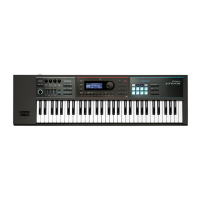55
MFX/Chorus/Reverb Parameters
63: STEP PCH SHIFTER
A pitch shifter in which the amount of pitch shift is varied by a 16-step sequence.
Step Pitch Shifter
Step Pitch Shifter
L out
EQ
2-Band
Parameter Value Explanation
Step 01–16 -24–+12[semi]
Amount of pitch shift at each step (semitone
units)
Rate # 0.05–10.0[Hz], note Rate at which the 16-step sequence will cycle
Attack # 0–127
Speed at which the amount of pitch shift
changes between steps
Gate Time # 0–127 Duration of the pitch shifted sound at each step
Fine -100–+100[cent] Pitch shift adjustment for all steps (2-cent units)
Delay Time 0–1300[msec], note
Delay time from the original sound until the
pitch-shifted sound is heard
Feedback # -98–+98[%]
Proportion of the pitch-shifted sound that is
to be returned to the input (negative (-) values
invert the phase)
Low Gain -15–+15[dB] Gain of the low range
High Gain -15–+15[dB] Gain of the high range
Balance # D100:0W–D0:100W
Volume balance of the original sound (D) and
pitch-shifted sound (W)
Level 0–127 Output level
MEMO
You can use MFX control to restart the step sequence from the beginning (p. 18,
p. 24).
64: REVERB
Adds reverberation to the sound, simulating an acoustic space.
L out
Reverb
2-Band
EQ
Balance W
Balance W
Balance D
EQ
Parameter Value Explanation
Type
Type of reverb
ROOM1 Dense reverb with short decay
ROOM2 Sparse reverb with short decay
STAGE1 Reverb with greater late reverberation
STAGE2 Reverb with strong early reections
HALL1 Reverb with clear reverberance
HALL2 Reverb with rich reverberance
Pre Delay 0.0–100[msec]
Adjusts the delay time from the direct sound until
the reverb sound is heard.
Time # 0–127 Time length of reverberation
HF Damp
200–8000[Hz],
BYPASS
Adjusts the frequency above which the
reverberant sound will be cut.
As the frequency is set lower, more of the high
frequencies will be cut, resulting in a softer and
more muted reverberance. If you do not want to
cut the high frequencies, set this parameter to
BYPASS.
Low Gain -15–+15[dB] Gain of the low range
High Gain -15–+15[dB] Gain of the high range
Balance # D100:0W–D0:100W
Volume balance between the direct sound (D)
and the reverb sound (W)
Level 0–127 Output level
65: GATED REVERB
This is a special type of reverb in which the reverberant sound is cut o before its
natural length.
L out
Gated Reverb
2-Band
EQ
Balance W
Balance W
Balance D
EQ
Parameter Value Explanation
Type
Type of reverb
NORMAL Conventional gated reverb
REVERSE Backwards reverb
SWEEP1 The reverberant sound moves from right to left
SWEEP2 The reverberant sound moves from left to right
Pre Delay 0.0–100[msec]
Adjusts the delay time from the direct sound until
the reverb sound is heard.
Gate Time 5–500[msec]
Adjusts the time from when the reverb is heard
until it disappears.
Low Gain -15–+15[dB] Gain of the low range
High Gain -15–+15[dB] Gain of the high range
Balance # D100:0W–D0:100W
Volume balance between the direct sound (D)
and the reverb sound (W)
Level # 0–127 Output level
66: OD
0
CHORUS
Chorus
Overdrive
R out
Balance W
Balance W
Balance D
Balance D
Parameter Value Explanation
Overdrive Drive # 0–127
Degree of distortion
Also changes the volume.
Overdrive Pan # L64–63R Stereo location of the overdrive sound
Chorus Pre Delay 0.0–100[msec]
Adjusts the delay time from the direct sound
until the chorus sound is heard.
Chorus Rate # 0.05–10.00[Hz], note Frequency of modulation
Chorus Depth 0–127 Depth of modulation
Chorus Balance # D100:0W–D0:100W
Adjusts the volume balance between the sound
that is sent through the chorus (W) and the
sound that is not sent through the chorus (D).
Level 0–127 Output level
67: OD
0
FLANGER
Flanger
Overdrive
L out
R out
Balance W
Balance W
Balance D
Balance D
Feedback
Parameter Value Explanation
Overdrive Drive # 0–127
Degree of distortion
Also changes the volume.
Overdrive Pan # L64–63R Stereo location of the overdrive sound
Flanger Pre Delay 0.0–100[msec]
Adjusts the delay time from when the direct
sound begins until the anger sound is heard.
Flanger Rate # 0.05–10.00[Hz], note Frequency of modulation
Flanger Depth 0–127 Depth of modulation
Flanger Feedback # -98–+98[%]
Adjusts the proportion of the anger sound that
is fed back into the eect.
Negative (-) settings will invert the phase.
Flanger Balance # D100:0W–D0:100W
Adjusts the volume balance between the sound
that is sent through the anger (W) and the
sound that is not sent through the anger (D).
Level 0–127 Output level
3
3
3
3
3

